
Metropolitan Stadium was an outdoor sports stadium in the north central United States, located in Bloomington, Minnesota, a suburb south of Minneapolis.
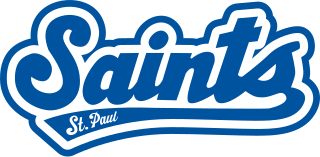
The St. Paul Saints are a Minor League Baseball team of the International League and the Triple-A affiliate of the Minnesota Twins. They are located in Saint Paul, Minnesota, and have played their home games at CHS Field since 2015. They previously played at Midway Stadium from 1993 to 2014.
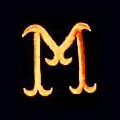
The Minneapolis Millers were an American professional minor league baseball team that played in Minneapolis, Minnesota, through 1960. In the 19th century a different Minneapolis Millers were part of the Western League. The team played first in Athletic Park and later Nicollet Park.

Wrigley Field was a ballpark in Los Angeles, California. It hosted minor league baseball teams in the region for more than 30 years. It was the home park for the minor league Los Angeles Angels during their run in the Pacific Coast League, as well as for the inaugural season of the major league team of the same name in 1961. The park was designed by Zachary Taylor Davis, who had previously designed both Chicago ballparks: Comiskey Park and Wrigley Field. The ballpark was also used as the backdrop for several Hollywood films about baseball, as well as the 1960 TV series Home Run Derby.

Comiskey Park was a baseball park in Chicago, Illinois, located in the Armour Square neighborhood on the near-southwest side of the city. The stadium served as the home of the Chicago White Sox of the American League from 1910 through 1990. Built by White Sox owner Charles Comiskey and designed by Zachary Taylor Davis, Comiskey Park hosted four World Series and more than 6,000 Major League Baseball games. Also, in one of the most famous boxing matches in history, the field was the site of the 1937 heavyweight title match in which Joe Louis defeated then champion James J. Braddock in eight rounds that launched Louis' unprecedented 11-plus year run as the heavyweight champion of the world.

Charles Albert Comiskey, nicknamed "Commy" or "The Old Roman", was an American Major League Baseball player, manager and team owner. He was a key person in the formation of the American League, and was also founding owner of the Chicago White Sox. Comiskey Park, the White Sox' storied baseball stadium, was built under his guidance and named for him.

Nicollet Park was a baseball ground located in Minneapolis, Minnesota, United States. The venue was home to the minor league Minneapolis Millers of the Western League and later American Association from 1896 to 1955.

Midway Stadium is the name of two different minor league baseball parks in Saint Paul, Minnesota, United States, both now demolished. The name derived from the location of the stadium in St. Paul's Midway area, so named because it is roughly halfway between the downtowns of Minneapolis and Saint Paul.
The Great Central League was a short-lived baseball league of four teams that played baseball in the upper Midwest of the United States in 1994. The league and four teams were owned by Minneapolis-based strip club owner, Dick Jacobson, who previously attempted to purchase the Rochester Aces of the Northern League.
The Western League was the name of several minor league baseball leagues that operated between 1885 and 1899. These leagues were focused mainly in the Midwestern United States.
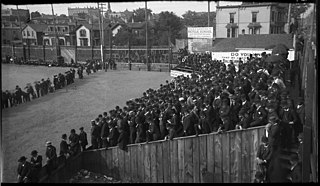
Athletic Park was the home of the Minneapolis Millers baseball team from 1889 to mid-season 1896. The park was located behind the West Hotel at 6th St and 1st Ave North in Minneapolis near where Target Center and Target Field are today.
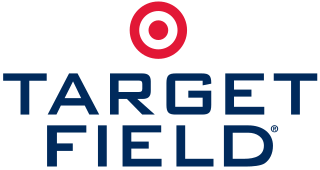
Target Field is a baseball stadium in the historic warehouse district of downtown Minneapolis. Since its opening in 2010, the stadium has been the home ballpark of Major League Baseball's Minnesota Twins. The stadium hosted the 2014 Major League Baseball All-Star Game. It also has also served as the home of other local and regional baseball events.
Stew Thornley is an author of books on sports history, particularly in his home state. He is an official scorer and online gamecaster for the Minnesota Twins. Thornley also does official scoring for Minnesota Timberwolves basketball games.
Halsey Lewis Hall was a sports reporter and announcer in the Minneapolis–Saint Paul area from 1919 until the 1970s.

Joseph John Hauser, nicknamed "Unser Choe", was an American professional baseball player who was a first baseman in the major leagues from 1922 to 1929, with the Philadelphia Athletics and Cleveland Indians. Hauser's major league career was undistinguished, but he made a name for himself in the minor leagues, where he became the first player ever to hit 60 or more home runs twice in a professional career: 63 in 1930, and 69 in 1933.

Andrew Paul (Pepper) Oyler was a Major League Baseball third baseman. He was born in Newville, Pennsylvania and attended Washington & Jefferson College. He played professionally for the Baltimore Orioles in the 1902 season. In 27 professional games that year, he had 77 at-bats with 17 hits and one home run.
James John Rantz is an American former professional baseball player and executive. He was the Minnesota Twins' farm system director from 1986–2012, holding the title of "Director of Minor Leagues." When he retired after his 27th consecutive season in the post, Rantz was one of the longest-tenured farm system directors in Major League Baseball; it was his 53rd consecutive season with the Twins' organization. From 1971 through 1985, Rantz was assistant minor league director under George Brophy. As such, during his career, he sent multiple generations of home-grown players to the Twins, and contributed materially to the team's 1987 and 1991 world titles and its run of playoff teams during the first decade of the 21st century.

The Twenty-Four-Inch Home Run: And Other Outlandish, Incredible But True Events in Baseball History is a book about baseball lore written by sportswriter Michael G. Bryson. The title refers to the book's central story, about a game where Andy Oyler hit a baseball that became stuck in the mud 24 inches in front of home plate, allowing him to score an inside-the-park home run before the opposing team located it. All told, the book contains 250 such stories, including an anecdote about a team registering a triple play without touching the ball. Bryson also debunks several well-known baseball legends, including Babe Ruth's called shot and the story that Abner Doubleday invented baseball.
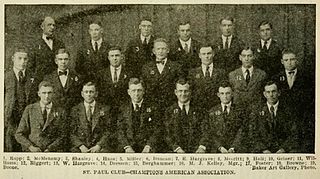
The St. Paul Saints were a 20th-century Minor League Baseball team that played in the American Association from 1901 to 1960 in the city of St. Paul, Minnesota. The 1920, 1922, and 1923 Saints are recognized as being among the 100 greatest minor league teams of all time.













